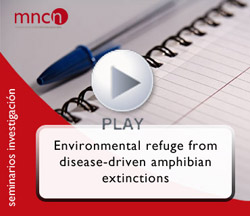Environmental refuge from disease-driven amphibian extinctions. Robert Puschendorf del la Universidad de Plymouth UK.
Título: Environmental refuge from disease-driven amphibian extinctions
Ponente: Robert Puschendorf del la Universidad de Plymouth, UK
Resumen:
Chytridriomycosis, caused by the fungus Batrachochytrium dendrobatidis (Bd), has been linked to extirpations and extinctions of amphibian species across the globe. The pathogen thrives in cool, moist environments, and high mortality rates have commonly occurred during outbreaks in amphibian populations in high-elevation tropical rainforests. In Australia several high-elevation species, including two out of the five torrent frog species (Litoria lorica, Litoria nyakalensis), were believed to have gone extinct during chytridiomycosis outbreaks in the 1980s and early 1990s.
Here present data on the unknown status of peripheral populations of torrent frogs in high elevation-dry forest and compare their abundance and disease status to the adjacent rainforest sites where amphibian populations have suffered well documented declines and even extirpations due to chytridiomycosis. Litoria nannotis in the dry habitat had significantly higher pathogen prevalence than those in the wet habitat, but were five times more abundant. I also discovered a previously unknown population of L. lorica and a population of the waterfall frog (L. nannotis) further downstream, both present at high abundance and with high prevalences of Bd infection. No individuals of either species showed clinical signs of disease, and they remained abundant during surveys over the following 4 years. I present a new hypothesis for how amphibians and this otherwise lethal pathogen can coexist, and discuss the conservation implications of our findings.
Seminario disponible en Cienciatk






